
It was great to be cold. Cold instead of hot. Wishing I had gloves. The wind, chill and mist. So different than chugging up Edison Road…

It was great to be cold. Cold instead of hot. Wishing I had gloves. The wind, chill and mist. So different than chugging up Edison Road…
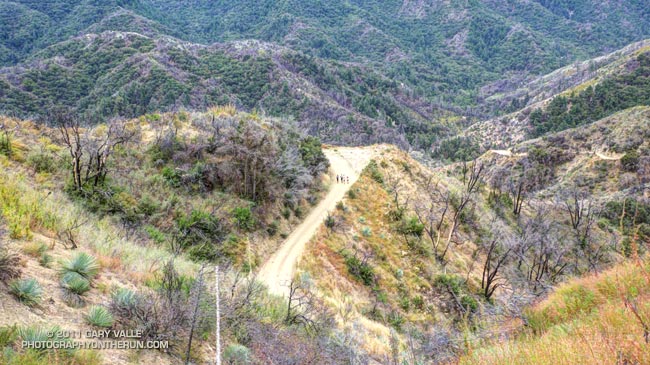
Runners on Edison Road During a Recent Training Run
Note: The Mt. Disappointment Endurance Run is now the Angeles National Forest Trail Race.
No matter if you run at the front, middle, or back of the pack, there’s the race you plan, and the race you run.
Based on the course info, it looked like the 7th edition of the Mt. Disappointment 50K was going to be more difficult than in 2009 and 2010, adding both mileage and elevation gain. Because of the closure of Mueller Tunnel and the damage done by the Station Fire and subsequent floods, we still wouldn’t be running up and over the shoulder of Mt. Disappointment, or down to Clear Creek and around Strawberry Peak, but the 2011 course would make up for that with its own very memorable sections.
To try and cope with the difficulties of the course, I’d put in extra miles and done more back to back Saturday-Sunday runs. But in one of those uh-oh moments a couple of miles into the race, I could feel in my legs that I was probably going to need to adjust my expectations. I wasn’t injured. I wasn’t getting over a cold or flu. My stomach wasn’t upset. I felt pretty good. But there was this nagging bit of fatigue in my legs…
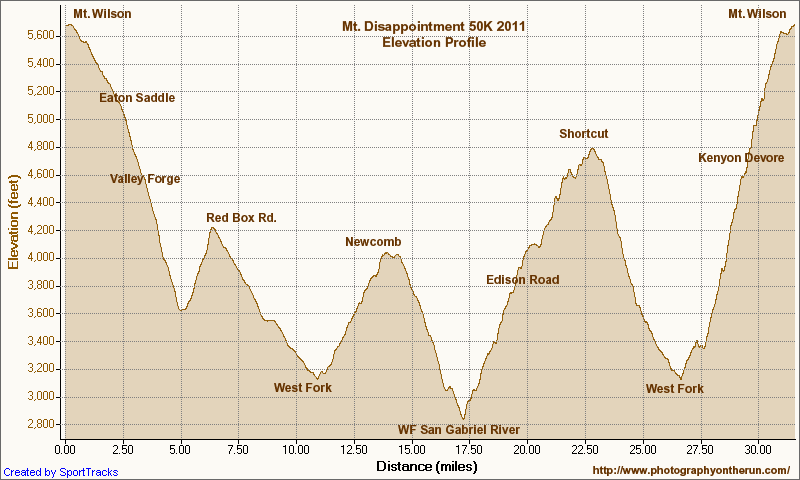
The new wrinkle for 2011 was that we turned off Mt. Wilson Road half-way to Red Box and ran down the Valley Forge Trail. In a training run a few weeks before the race, the Valley Forge Trail had been an obstacle course overgrown with Turricula (Poodle-dog bush). Trail work by Hilliard, Rowlan & Company had restored the trail, and today it was in great shape. Here’s an interactive Cesium browser View of the 2011 course and the courses in previous years, and an elevation profile of the 2011 course.
At the bottom of the Valley Forge we turned onto the Gabrielino Trail, and started up the canyon of the West Fork toward Red Box-Rincon Road. The change in grade from level to uphill confirmed it. I stepped aside so two running friends could pass. Maybe it was a tapering or over-training issue, or maybe it was just “one of those days.” Whatever, the legs were just not cooperating.
The irony is, this was probably a good thing. The day turned out to be the hottest of any Mt. Disappointment race to date. The lurking leg fatigue forced me to not push the pace, which made dealing with the temperature easier.
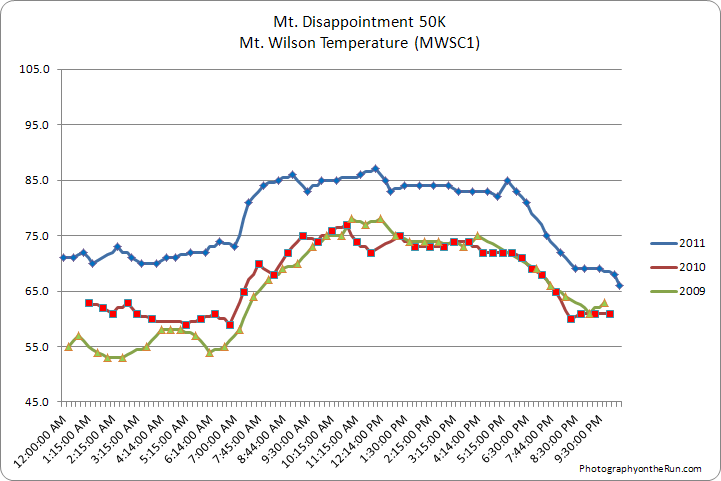
And hot it was! The forecast had looked decent just two days before the race, but Friday temperatures exploded in the mountains, jumping 10-12 degrees in 24 hours. The hot temps on Friday carried over into Saturday, making race day just that much warmer.
Here are the race day temperatures at Clear Creek and Chilao for 2005-2011, and Mt. Wilson for 2009-2011. And these temps are the temperature off the ground and in the shade! A better indication of the temperature in the sun is the “fuel temperature.” This is the temperature of a ponderosa pine dowel in direct sun. Here are plots of the race day fuel temperature at Clear Creek and Chilao for 2005-2011.
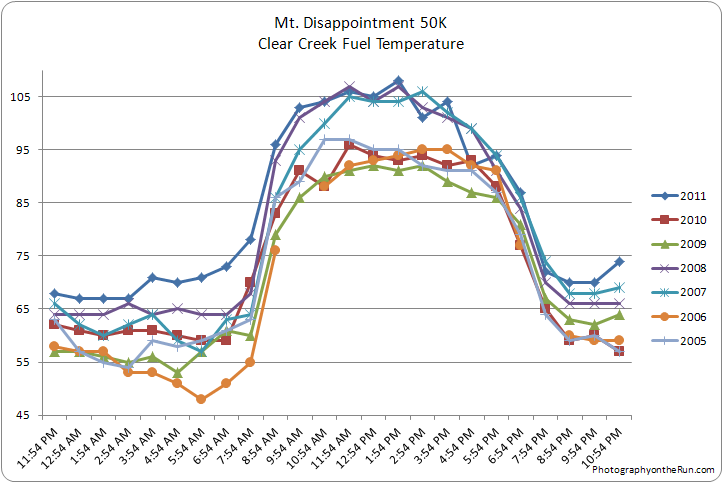
Because I wasn’t pushing the pace I didn’t hesitate to take a little extra time at aid stations. I can still feel that ice cold sponge on the back of my neck, and the cold water running down my back. This year there were numerous small stream crossings, and I think there was at least one small stream between every aid station. This was “free” cooling, and I paused a dozen times to dump water over my head. Thanks to the West Fork San Gabriel River, I was soaked from head to toe for the first steep, sun-baked section of Edison Road. This was also the case on the Silver Moccasin Trail in Shortcut Canyon and on part of Kenyon Devore.
Hot day or not there were some remarkable performances. Heather Fuhr was not only was the first place woman, she was fourth overall and set a new women’s course record of 5:07:11. Perennial favorite Jorge Pacheco sped through the tough Mt. Disappointment course in 4:46:29, winning the overall and setting a new course record in the Men’s 40-49 Division.
Once again the event was superbly organized by race director Gary Hilliard and the Mt. Disappointment 50K Staff, with the help of an extraordinary group of volunteers, runners, SAR personnel and sponsors. Thank you!
Related post: Mt. Disappointment 50K 2010 Notes
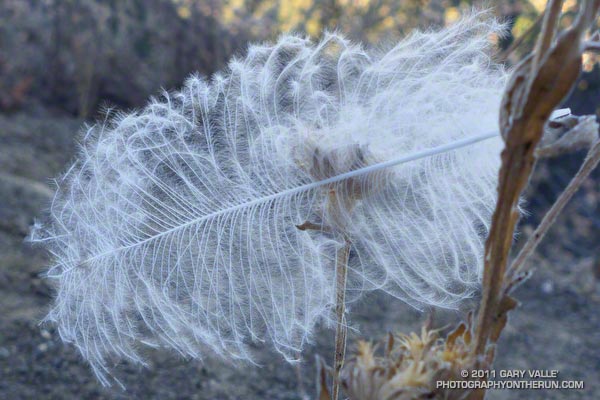
This intricate feather was caught on a bristly stalk along the Secret Trail (Calabasas – Cold Creek Trail). The slightest breath of wind would jostle its branches and branchlets. I found I was holding my breath, waiting for the still moments when I could take a photograph. The feather is smaller than the photograph suggests, perhaps 1.50″-1.75″ in length.
There are several types of bird feathers, the most familiar of which is probably the contour feather. The Feather on the Modelo Trail is a contour feather. In a sense contour feathers form the outer shell of a bird, defining its form and coloration. Wing and tail feathers are contour feathers. The fluffy feather with a familiar name — the down feather — provides insulation.
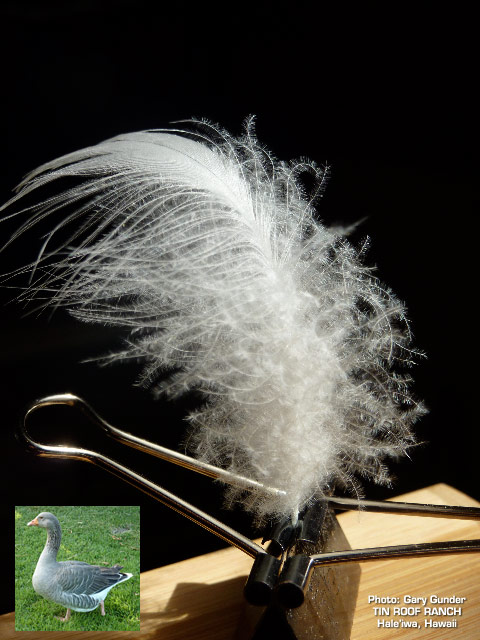
The feather found along the Secret Trail is a semiplume feather. A semiplume feather looks like it is a blend of a contour feather and a down feather, and has some of the characteristics of both. Like a contour feather it has a supportive shaft, but like a down feather it has filamentary branches (barbs) and branchlets (barbules). This combination helps to fill out the bird’s shape, and also provides additional insulation.
The barbules of contour feathers have hooks (barbicels) which join adjacent barbs to form the blade-like vanes of the feather. The barbules of semiplume and down feathers do not have hooks. This allows the barbs of the feather to spread in three dimensions and more easily fill a space. Here’s a closer view of the barbs and barbules of the Secret Trail feather.
To see how the Secret Trail feather compares to other semiplume feathers, I asked long-time climbing, kayaking, and running partner Gary Gunder — now living the good life on the North Shore — if he could take some photos of feathers from some of the birds at Tin Roof Ranch. Courtesy of Gary, here are photos of semiplume feathers from a chicken, turkey, and goose.
For more about feathers and birds see Feather Structure on the Cornell Lab of Ornithology All About Birds web site.
P.S. I asked Gary how his running is going, and he replied, “I run every day… across the Kamehameha highway to go surfing!”

Poodle-dog bush* sprouting at the junction of the PCT and Mt. Waterman Trails, near Three Points.

Little plants like these can grow to be monster-sized, like these along Edison Road, below Shortcut Saddle.
The title photo was taken on a run around Mt. Waterman from Three Points on May 29, 2011 and the photo of the monster-sized Poodle-dog bush was taken on a Mt. Disappointment 50K training run from Shortcut Saddle on July 31, 2011.
*The taxonomic name for Turricula parryi (Poodle-dog bush) has changed to Eriodictyon parryi. The Jepson Manual: Vascular Plants of California, Second Edition (2012) has returned Turricula to the genus Eriodictyon, as originally described by Gray. According to the Wikipedia entry for Turricula (April 11, 2012), “… molecular phylogenetic analysis carried out by Ferguson (1998) confirms that Turricula should be treated as a separate genus within a clade (Ferguson does not use the term “subfamily”) that includes Eriodictyon, and also the genera Nama and Wigandia; Eriodictyon is the genus to which Turricula is closest in molecular terms, and is its sister taxon.” I use “Turricula” and “Poodle-dog bush” interchangeably as a common name.
Related posts: Contact Dermatitis from Eriodictyon parryi – Poodle-dog Bush, Getting Over Poodle-dog Bush Dermatitis, Trail Runners Describe Reactions to Poodle-dog Bush